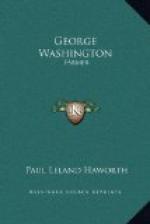The dry weather continued and presently he notes that all the poplars, black gums and pines, most of the mulberries, all of the crab apples and papaws, most of the hemlock and sassafras, and several of the cedars are dead, while the tops of the live oaks are dead but shoots are coming up from the trunks and roots. The Chinese grasses are in a bad way, and those that have come up are almost entirely destroyed either by insects or drought. None of this grass survived the winter, though he took the trouble to cover it with straw.
During the fall of 1785 and spring of 1786 he sowed the lawn with English grass seeds, replaced the dead trees in the serpentine walks and shrubberies, and sent two hundred and fifteen apple trees to his River Plantation. He made the two low mounds already mentioned and planted thereon weeping willows. He set out stocks of imported hawthorns, four yellow jessamines, twenty-five of the Palinurus for hedges, forty-six pistacia nuts and seventy-five pyramidical cypress, which last were brought to him by the botanist Michaux from the King of France. As 1786 was one of the wettest summers ever known, his plants and trees lived better than they had done the preceding year.
During this period and until the end of his life he was constantly receiving trees and shrubs from various parts of the world. Thus in 1794 he sent to Alexandria by Thomas Jefferson a bundle of “Poccon [pecan] or Illinois nut,” which in some way had come to him at Philadelphia. He instructed the gardener to set these out at Mount Vernon, also to sow some seeds of the East India hemp that had been left in his care. The same year thirty-nine varieties of tropical plants, including the bread fruit tree, came to him from a well wisher in Jamaica. At other times he sowed seeds of the cucumber tree, chickory and “colliflower” and planted ivy and wild honeysuckle. Again he once more planted pecans and hickory nuts. It can hardly be that at his advanced age he expected to derive any personal good from either of these trees, but he was very fond of nuts, eating great quantities for dessert, and the liking inclined him to grow trees that produced them. In this, as in many other matters, he planted for the benefit of posterity.
In order to care for his exotic plants he built adjoining the upper garden a considerable conservatory or hothouse. In this he placed many of the plants sent to him as presents and also purchased many others from the collection of the celebrated botanist, John Bartram, at Philadelphia. The structure, together with the servants’ quarters adjoining, was burned down in December, 1835, and when the historian Lossing visited Mount Vernon in 1858 nothing remained of these buildings except bare walls crumbling to decay. Of the movable plants that had belonged to Washington there remained in 1858 only a lemon tree, a century plant and a sago palm, all of which have since died. The conservatory and servants’ quarters have, however, been rebuilt and the conservatory restocked with plants such as Washington kept in it. The buildings probably look much as they did in his time.




